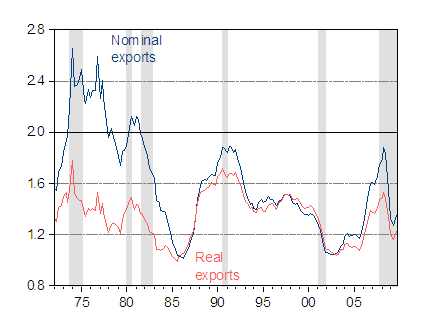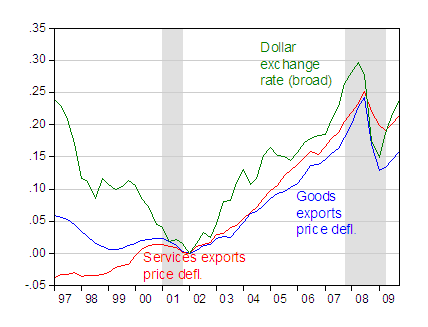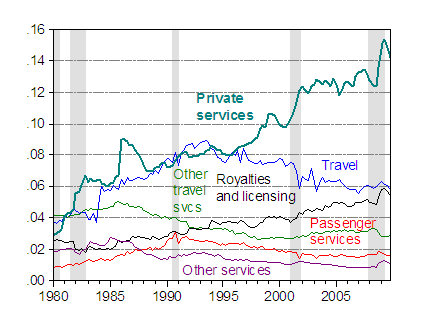The Administration has committed itself to doubling exports in five years, via the National Export Initiative. Much of the journalistic coverage has focused on the regulatory, trade-credit financing, and export promotion measures being considered [0]. I wanted to take a macro oriented approach to the viewing the plausibility of this goal. Let me address this issue from a variety of perspectives.
The historical record
First, has a doubling of exports ever occurred in the past forty or so years? The answer is yes!

Figure 1: Ratio of nominal exports to exports 5 years earlier (blue), and real exports (red). NBER defined recessions shaded gray; assumes last recession ended 09Q2. Source: BEA GDP 2009Q4 advance release, NBER, and author’s calculations.
Notice that nominal exports certainly doubled in the mid-1970s and early 1980’s. Nominal exports also almost doubled by 1990 and 2008, approximately 5 to 6 years after peaks in the trade-weighted exchange rate. (Real exports seldom exceed a 50% increase).
Hence, the objective of doubling nominal exports is clearly possible. From a macro perspective, whether the doubling occurs depends upon (i) the price level of exports, (ii) the quantity of exports.
The price of exports
Clearly, the price of exports matters both directly (by affecting the price of each unit of exports) and indirectly (by affecting the quantity of exports) for nominal exports. First, we can examine the relationship of the price level to the exchange rate.

Figure 2: Log price of goods exports (blue), of services exports (red), and log dollar exchange rate against a broad basket of currencies (green), all normalized to 0 at 2002Q1. NBER defined recessions shaded gray; assumes last recession ends 09Q2. Source: BEA GDP 2009Q4 advance release, Federal Reserve Board, NBER, and author’s calculations.
Here, the implied pass through is substantially higher than import pass-through [1], but in line with the estimate of 0.75 reported by Vigfusson, Sheets and Gagnon [link fixed, 2/5 9am] for the US.
Hence, sustained dollar depreciation could aid in hitting the target in a direct fashion.
The quantity response
The quantity of exports depends on (1) rest-of-world GDP, (2) the real exchange rate, and (3) US supply of exportables. (1) and (2) enter into standard elasticities approach equations; (3) has been included in studies such as Helkie and Hooper (1988), as well as more recent studies by me [2]. Omitting the supply side artificially imputes to rest-of-world growth the supply side if the two variables co-trend.
For the moment, consider the basic specification omitting the supply side, as discussed in this post from last October, but estimated over the 1973Q1-2009Q4 period:
Δ exp t = θ 0 + ρ exp t-1 + θ 1 y* t-1 + θ 2 r t-1 + σ 1 Δ exp t-1 + σ 2 Δ y* t-1 + σ 3 Δy *t-2 + σ 4 Δ r t-1 + v t
Where exp is real exports of goods and services, r is the real exchange rate, and y* is the rest-of-world GDP. Note that the rest-of-world GDP variable is the export weighted real GDP calculated by the Federal Reserve Board, for 1970q2-07q4; the 2008q1-09q3 data I estimated using a regression of GDP on a current and four lags of industrial country industrial production, time trend, trend squared, and world GDP ex.-US.
(Data sources: BEA 2009q4 advance release for imports, exports, GDP; Federal Reserve Board for broad index of real dollar value; personal communication/Fed for rest-of-world export weighted GDP; and IMF International Financial Statistics for industrial country industrial production (nsa), and GDPs used to project rest-of-world GDP.)
The implied long run price elasticity is 0.82, and the long run income elasticity is 1.81. The price elasticity is higher than that obtained by DOLS in this paper, based on export data up to 2007, but the income elasticity is about the same. Hence, continued dollar depreciation would have a substantial direct impact on export quantity. But rapid rest-of-world growth could be even more important, given the high income elasticity. (The rest-of-world GDP variable is export-weighted, so this characterization pertains to US export markets.)
In my working paper, augmenting the basic specification with a supply variable (industrial production) halves the income elasticity. This complicates the issue; then one needs to know how the supply of exportables will evolve over time.
I am the first the confess that the measure I use for the supply of exportables is wanting. One could use a measure of the capital stock (as in Helkie and Hooper). But I think no measure is particularly satisfying, especially given the fact that over one-third of exports are in the form of services, and a full 15% are “private services”, including business, professional and technical services.

Figure 3: Shares of total exports. NBER defined recessions shaded gray; assumes last recession ends 2009Q2. Source: BEA GDP 2009Q4 advance release, NBER, and author’s calculations.
Complications: Vertical Specialization, etc.
In a number of posts [3] [4] [5], I’ve argued that vertical specialization — the use of imported inputs for subsequent exports — is important in thinking about how trade flows respond to exchange rates and incomes. While it’s likely that the degree of vertical specialization is less for the US than other, smaller, developed economies, it’s plausible that it’s been increasing over time. If this is so, then measured exports could be rising at a noticeably higher rate than the value-added component of exports. In other words, I’m positing an upward trend in gross exports to GDP that is not as marked as the value added in exports as a share of GDP. This upward trend helps make the goal of a doubling of gross nominal exports more feasible.
Of course, this effect relies upon a continuation of “product fragmentation” or “globalization”. That process might have been slowed by rising energy prices, or rising transactions (including credit) costs, as discussed here and here.
Bottom Line
So, if you didn’t know it already, achieving the goal of doubling nominal exports depends upon exchange rate pass through, the extent of exchange rate depreciation, the rate of rest-of-world GDP growth, and the evolution of export supply (of both goods and services).
I think a more relevant question is: How probable is a doubling of trend exports?
Obama needs a trend doubling. His point is that he wants export related employment increaeses. An increase in export related jobs is only meaningful if it is persistent.
So what you’re saying is, doubling exports in nominal dollar terms might be achieved through aggressive dollar devaluation. Is that a recommendation?
A little too linear,when attempting to back test the results.
A low dollar against other currencies did not provide for an upsurge of exports years 2000 2005.
Which US products for export are so elastic to the dollar parity?
Financial services did not even match UK in external revenues (Thomas Philippon study)
The link to Vigfusson, Sheets and Gagnon is not operating.
All financial engineering have failed for all countries addicted to the stuff.
Vulnerant omnes, ultima necat All hours hurt, the last one kill
Shouldn’t you be looking at NET exports? If imports increase 100% over 5 years, but so do imports, what good did it do us?
What we need is a rise in net exports, and it’s almost inevitable. But it will probably be due more to a fall in imports than a rise in exports.
Tom: No, it’s not a recommendation.
ppcm: Thanks for the information regarding the broken link; now fixed. All your other comments are incomprehensible to me, I regret.
Bob_in_MA: I’ve previously examined imports, exports and net exports in these posts, [1] [2] [3] [4] [5] [6] [7] [8] as well as these papers: [1] [2] [3]. Some of these links were cited in the post above; please click through.
Given that dollar devaluation didn’t lead to good economic outcomes in the late 70s, late 80s or 00s, why would we pursue such a policy? If you don’t advocate devaluation, is there any other way to accomplish the goal? Is there any reason to believe that doubling exports is a worthy goal by itself? Is there something special about selling things to foreigners that makes it more valuable to us as a country?
The linear forecast of exports is not matching the US currency depreciation which took place throughout the period 2000 2005
Please see
EUR/USD (EURUSD=X) Yahoo finance
The net variation of total export of services is of a amount of 60 Billion usd (rough figure) to 80 billion usd in 2005 (with a surprising uprise afterwards) Please see FRED
http://research.stlouisfed.org/fred2/series/BOPXSV
The net variation of exports of goods service and income brought from 300 billion usd in 2000 to 400 billion usd in 2005
http://research.stlouisfed.org/fred2/series/BOPX
I do not see any information regarding the source and breakdown of services revenues brought from 40 billion usd in 2000 to 60 billion usd in 2005
http://research.stlouisfed.org/fred2/series/BOPXSVT
Travel 15 Billion USD in 2000 brought to 27 billion usd in 2010
http://research.stlouisfed.org/fred2/series/BOPXSVT
ppcm: I didn’t say there was a one-for-one correspondence. If you run a (linear) regression with lags allowed for, you can get a prediction that does not incorporate a one-for-one correspondence. If you are arguing that perhaps there is a nonlinearity of a threshold sort (so a threshold autoregression, or threshold cointegration), that may very well be the case, although offhand I am not aware of any recent papers of that sort pertaining to US data.
Note that the data I used are from the national income and product accounts, at the BEA website, and not the balance-of-payments data shown in the FRED series you cite.
So… the USG has joined the League of 192 Nations that believe they need to export more. A plan starts with an idea, so we have a start at least.
We will need to find our niche, of course, and CDO/CDS has been waning in popularity both in foreign markets and at home.
Tourism counts, so maybe it’s Vegas and Disney World??? How do we distribute the money(jobs) around the country in that case?
The other possibility is residential and commercial real estate sales, but I’m not sure how that gets captured in the data.
Also, there is a strong marginal propensity for US multi-nationals to localize production in foreign markets, and it’s hard to see how that would change without a large de-val in the dollar.
We do have strong exports in some of our industries, but for those to double, it would take lots of growth in foreign market size.
Could that be an explanation for the prevalence of non linearity?
US assets abroad net outflows
http://alfred.stlouisfed.org/series?seid=BOPOA&cid=127
The passthrough from dollar depreciation to export prices in Vigfusson et al is estimated with historical data. Sometimes the dollar depreciates for monetary reasons, likely high passthrough, and sometimes the dollar depreciates for real or demand reasons, likely low passthrough.
The administration can reach its goal if it can generate a sustained inflation. High inflation; fast monetary driven depreciation, rapid rise in nominal exports. This was clearly the main source of export growth in the 1970s.
The Administration just has to convince the Fed to expand its balance by a couple more trillion or convince congress to run large deficits for a while.
The Secret Economist,
Was that the same ’70s where the Japanese came in and cleaned our clocks? Or was I just imagining things?
But other than that, it sounds like a fun plan. Maybe we will get good music again, finally legalize pot, and I’m looking forward to the mini-skirts.
Tom and Joe: How can anyone recommend Devaluation for the US when it is only possible in a country that is on a fixed or semi-fixed exchange rate?
Sorry, if this question is foolish. I’m just a student.
Well, anyhow, it’s a good idea to do more export promotion and facilitation.
But setting such an unrealistic growth target probably won’t help, and might hurt as the administration seems likely to quickly turn to suppressing the memory that it ever promised such a thing. I would hope it helps somebody in the administration think a bit about how the fiscal deficit is the biggest enemy of exports, but I’ve given up hoping for anything from them.
KC: No, central banks regulate the value of their currencies by manipulating the money supply. A fixed exchange rate means the central bank commits to manipulate the money supply as needed to maintain a particular exchange rate.
It’s like the difference between a driver who uses the pedal, and a driver who uses cruise control. Both are perfectly capable of doubling their speed; the only difference is the latter makes a commitment to maintain the new speed.
So apparently the administration is committed to drastic dollar devaluation. I would expect the nominal price of key imports – particularly oil – to rise in inverse proportion. But when oil got very high not long ago, the results where not exactly salubrious.
This reminds me of the cliché about deck chairs on the Titanic. Is it even possible for the USA raise exports drastically in five years in a manner such that ordinary people experience a benefit, or will they simply be crushed by unaffordable fuel prices instead of by something else?
Professor Chinn is not satisfied with any measure of the supply of exportables in his equations. Good. Industrial production records what was produced in the past (production must be sold to continue production). In order for industrial production to be sold as an export it must be more valuable than competor products from other nations. The exchange value of the dollar influences the comparison of value. In addition, the quality of the product as perceived by the importer is highly important.
In my view, the way to improve the quality of products exported from the U.S. is to restrict imports by a non-protectionistic scheme. Quality of exports cannot improve so long as imports take the place of domestic production.
Imports the U.S. government can control. The value of the dollar it cannot control. The ability of foreign nations to pay for exports it cannot control. The quality of competitor exports from other nations it cannot control. The only thing the U.S. government can do to improve the quality of U.S. exports in to provide them with a home market in which they can imporve the quality of their product.
Since 69% of U.S. exports were goods the last time I looked, this issue of expanding exports must focus on the quality of goods produced in the U.S. And import restrictions are the only means available to the U.S. government to help.